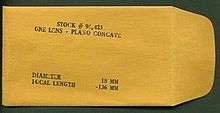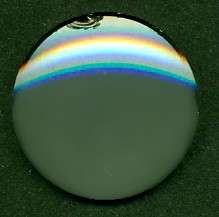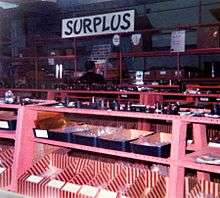Edmund Scientific Corporation
Edmund Scientific Corporation, based in Barrington, New Jersey, is a subsidiary company of Science Kit and Boreal Laboratories. Originally independent, the company was known best for supplying surplus optics and other items via its mail order catalog and Factory Store.
History
In 1942, amateur photographer Norman W. Edmund (1916 - 2012[1]) found it hard to find lenses he needed for his hobby. This led him to advertise lenses for sale in photography magazines. It was so successful he founded "'Edmund Salvage Corporation'". It soon changed its name to Edmund Scientific and made its name with ads in publications like Scientific American as a supplier of chipped lenses, war-surplus optics, and low cost scientific gadgetry. Its advertisements caught the attention of hobbyists, amateur astronomers, high school students, and cash-strapped researchers.
War surplus


Edmund Scientific was part of the post-World War II "war surplus" phenomenon, when the U.S. government sold off large quantities of materials. "Army and Navy Stores" were a national phenomenon and originally sold military-surplus clothing. Surplus electronics found an outlet in dozens of shops, in New York City's "Radio Row" and elsewhere. A few issued catalogs and developed national mail-order businesses. Edmund was, however, the only widely known supplier of surplus optics.
The core of Edmund's offerings was surplus lenses. These were single-element lenses, shipped in 2.5-by-4.25-inch (64 mm × 108 mm) coin envelopes, with the approximate diameter and focal length stenciled on them. Reflecting their salvage and surplus origins, available diameters and focal lengths did not fall into regular progressions. Edmund published crudely printed, stapled "books" describing experiments that could be performed with their lenses, and plans for building telescopes and other optical equipment. Edmund also sold lens "kits". The 10-lens kit cost less than US$10 and included a booklet of plans for instruments which could supposedly be built with them.
Unlike Heathkits, which were absolutely complete kits requiring only soldering and assembly, Edmund's "kits" consisted of only the lenses. A great deal of skill and effort was still needed to fashion the telescopes, microscopes, or opaque projectors described. With single-element lenses, the quality of the resulting optics was not high. Edmund even sold high-quality, thick, black cardboard tubes needed for many of the projects.
Heyday

Following Sputnik, Edmund was able to capitalize on a growing national interest in science and astronomy. They expanded their business into a full line of telescopes and telescope kits as well as equipment, parts, and supplies for other scientific fields such as physics, optics, chemistry, microscopy, electronics, and meteorology. They continued to grow as a supplier to teachers and schools with demonstration devices and kits which covered most fields of science.
Edmund's catalog became a source for optical and mechanical parts essential to amateur telescope making, including hard-to-find items such as optical glass blanks, pitch-lap ingredients, and a series of grit abrasives for grinding and polishing astronomical objective mirrors by hand. A compilation of Edmund's earlier pamphlets published as the book "All About Telescopes" offered many designs for telescopes of all sizes and configurations, which directed the builder to the relative Edmund catalog part numbers needed for each design. The "Factory Store" in Barrington, New Jersey also had a number of bins and shelves full of rare surplus items which never made it into the catalogs.
Edmund's catered to the 1960s generation by expanding and highlighting their line of projectors, color wheels, black lights, filters, and other optical devices which could be used by rock bands and in psychedelic light shows. Other items catering to the counterculture were eventually added to the catalog covering the fields of Biofeedback, ESP, Kirlian photography, Pyramid power, and alternative energy.
In 1971, in the Whole Earth Catalog of items "relevant to independent education", Stewart Brand noted:
"Edmund is the best source we know of for low-cost scientific gadgetry (including math and optics gear). [In this category,] many of the items we found independently... turned up in the Edmund catalog, so we were obliged to recommend that in this area we've been precluded."
Some sources claim that certain of the original polyhedral dice used in the Dungeons & Dragons role-playing game system were obtained from Edmund Scientific.[2]
Restructuring
In the 1970s, as the viability of Edmund's business model waned, Norman Edmund's son Robert Edmund refashioned the business into two new ones, Edmund Scientifics and Edmund Optics. Edmund Scientifics marketed to consumers and specialized in science-themed toys, vaguely high-tech household gadgets, and "science gifts." Edmund Optics did not have a public showroom like Edmund Scientifics, although the two organizations shared the same building. The large back room of Edmund Scientifics still sold military surplus from World War II and other wars well into the 1980s and into the mid-1990s. Some of the items in the surplus room were from German and other non-American militaries. None of these items were in the mail-order catalogs. They also sold other surplus wares of interest to hobbyists, including specialized motors and other miscellaneous electronics, parts from toys, and other household items.
In line with their focus on optics, Edmund Scientifics's entrance vestibule housed a pale-blue working World War II Japanese submarine periscope. Children were often drawn to this periscope. Drawing on the periscope's popularity, sometime in the 1970s a hall of mirrors, complete with black lights, was installed toward the rear of the building.
Acquisition
In 2000 Edmund Scientific was purchased by Science Kit and Boreal Laboratories, a western New York based science supply company. Science Kit and Boreal Laboratories is part of a group of companies that provide science supplies to elementary, middle, and high schools, as well as colleges and universities. This group falls under the unofficial umbrella "VWR Education", and its constituent enterprises are owned by VWR International, a multi-national conglomerate with offices in India, China, Europe, Canada, and the United States. They are no longer affiliated with Edmund Optics Inc.
Beginning in 2000, Edmund Optics offered a variety of experimental grade and stock clearance items via a print catalog and online under a separate business named Anchor Optics, but this operation ceased in 2016, and the current Anchor Optics web site now redirects to a page at Edmund Optics listing clearance items.[3]
In 2001, the Barrington, New Jersey, store closed after Edmund Scientific was acquired by Science Kit and Boreal Laboratories.
As of 2009, online sales made up the bulk of Edmund Scientific's revenues. The company was still selling telescopes (including an updated version of their Astroscan Telescope), microscopes (mostly they have carried the Boreal brand, manufactured for their parent company Science Kit LLC), surplus optics, magnets, and Fresnel lenses. They continued to sell many of their old favorites along with new items such as the Impossiball and hand boilers as well as other science-themed toys, novelty items, gifts, and gadgets.
As of 2017, Edmund Optics continued to offer brand-new stock optics, as well as offering custom and specialized optics to corporations and higher education institutions.
In popular culture
Edmund Scientific has provided items used in television shows such as House, MythBusters, 24, Modern Marvels, and motion pictures such as Star Trek, and the 1975 version of Escape to Witch Mountain. Wah Chang, the artist who designed and built several props in the 1960s for the Star Trek television show, used moiré patterns found in the Edmund Scientific Educator's and Designer's Moiré Kit for the texture used in the Starfleet communicator props.[4]
In the Simpsons episode "Two Bad Neighbors", Bart Simpson releases locusts from a box labeled Edmund Scientific.[5]
See also
- Astroscan, a wide-field Newtonian reflector telescope produced by the Edmund Scientific Corporation.
References
- "Edmund Optics Mourns the Loss of Founder, Norman W. Edmund" (Press release). Edmund Optics. 2012-01-17. Archived from the original on 2012-01-22. Retrieved 2012-01-23.
- Contrarian (2008-03-05). Blog posting in RPGnet Forums: Where'd the first d20's come from?, dated "03-05-2008, 10:21 PM". Retrieved on 2016-03-05 from https://forum.rpg.net/archive/index.php/t-382854.html.
- "Anchor Optics". Archived from the original on 2016-05-04. Retrieved 2017-07-23.
- herocomm.com - The Details... A Moiré Story
- "[3F09] Two Bad Neighbors". The Simpsons Archive. Archived from the original on 1997-07-10. Retrieved 2013-08-16.
Bibliography
- Preface to Edmund Scientific Catalog 751 Copyright 1974, Edmund Scientific Co.
External links
- https://www.edmundscientific.com/ [Broken link]
- www.edmundoptics.com — Edmund Optics professional optics company
- www.scientificsonline.com — Edmund Scientifics science supplies and gifts company